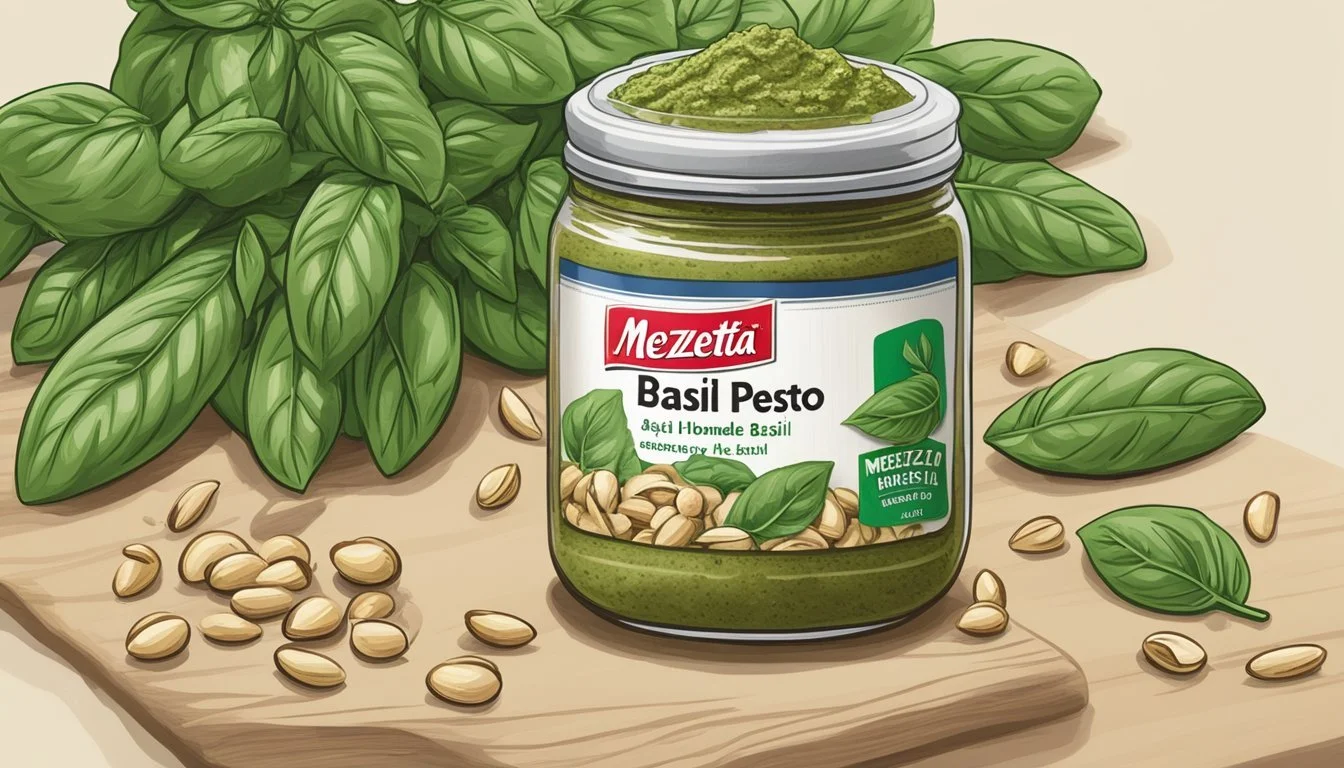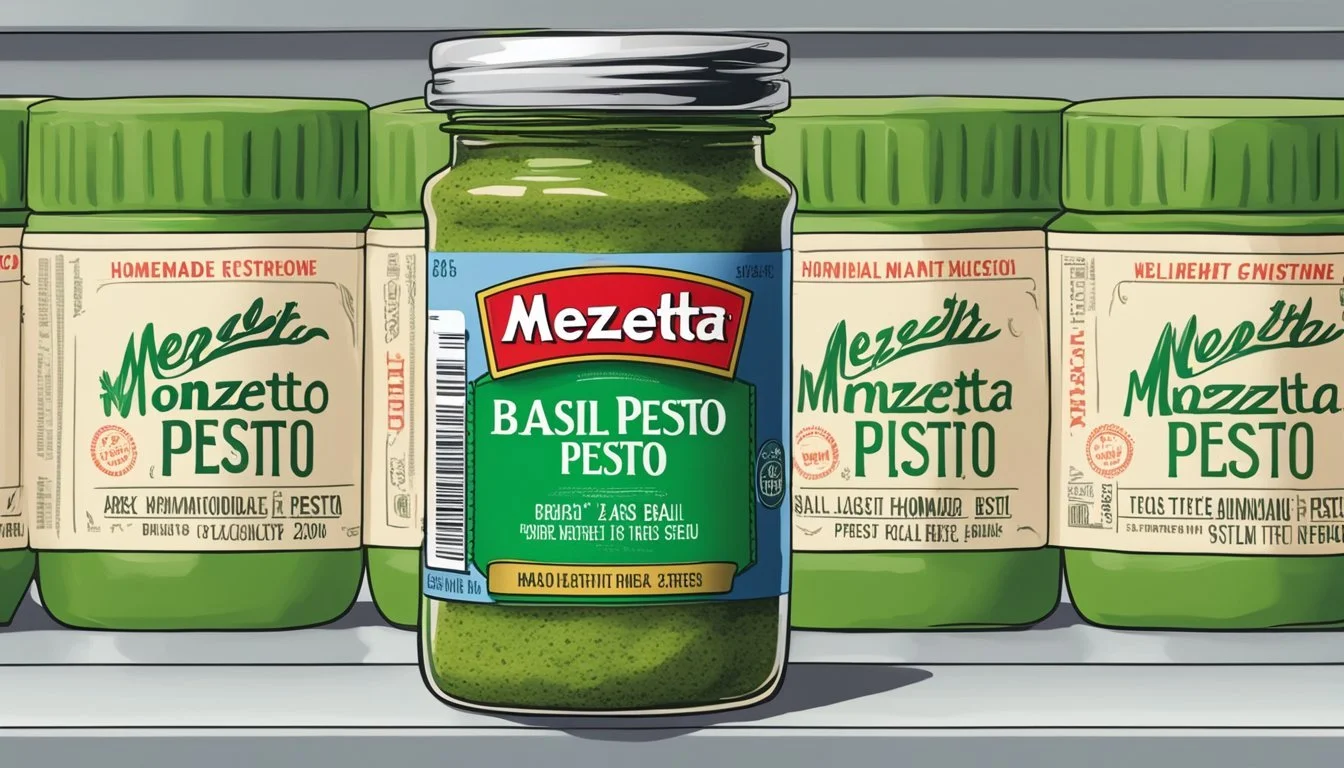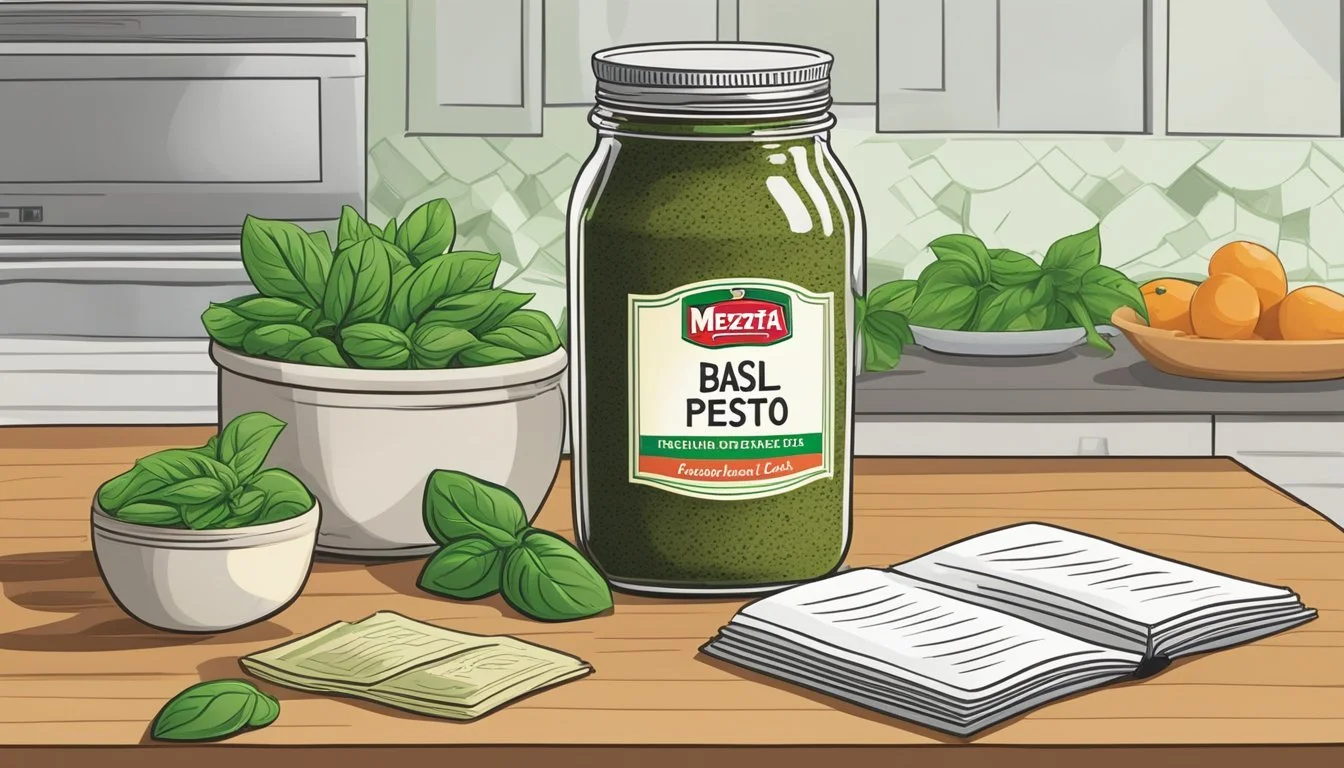How Long Does Mezzetta Homemade Style Basil Pesto Last?
Shelf Life and Storage Tips
When it comes to preserving the vibrant flavors of Mezzetta Homemade Style Basil Pesto, storage conditions and duration are critical. Pesto, a blend of fresh basil, olive oil, pine nuts, parmesan cheese, and garlic (What wine goes well with garlic?), is treasured for its fresh and aromatic qualities. The shelf life of pesto is determined by various factors, including its ingredients, the presence of preservatives, and the way it is stored after opening.
For Mezzetta Homemade Style Basil Pesto, the difference between store-bought and homemade varieties is an important consideration. Store-bought pestos like Mezzetta's often include preservatives that extend their shelf life compared to homemade alternatives. While homemade pesto can typically last up to a week in the fridge, Mezzetta's jarred pesto has a longer shelf life due to its carefully controlled production process and added preservatives.
Consumers should be aware that the shelf life of pesto can be further extended by freezing, which can be especially useful for homemade variations that lack commercial preservatives. However, whether store-bought or homemade, the texture and flavor of the pesto can change over time, with the pungent taste of garlic and the richness of nuts potentially becoming less pronounced. Despite these changes, the essential components, like olive oil and parmesan cheese, help to preserve the condiment's integrity under proper storage conditions.
What Is Basil Pesto?
Basil pesto is a vibrant and fragrant sauce with roots in Genoa, a city in northern Italy. This unalienable condiment has become a beloved addition to numerous dishes worldwide. Its core ingredients include:
Fresh basil leaves: The star of the sauce, providing a fresh and slightly peppery flavor.
Pine nuts: Often gently toasted to enhance their nutty essence.
Olive oil: A quality extra-virgin variety is preferred for a smooth and rich texture.
Garlic: Adds a pungent kick that complements the herbs.
Parmesan cheese: Aged Parmigiano-Reggiano lends a salty depth.
The traditional technique for creating basil pesto involves crushing or grinding the ingredients, which is reflected in its name – 'pesto' stemming from the Italian verb pestare, meaning to pound or crush. This method releases the full spectrum of flavors, melding them into a cohesive sauce.
Modern interpretations of pesto may swap pine nuts with other varieties, such as walnuts or almonds, though purists advocate for the classic composition. The ideal homemade pesto balances the robust flavors of garlic and cheese with the freshness of basil, tied together by the richness of olive oil.
In its essence, basil pesto represents a harmony of simple components that, when combined, create a versatile and dynamic flavor profile suitable for pastas, spreads, marinades, and more. This staple of Italian cuisine remains a testament to the power of fresh, quality ingredients.
Homemade Pesto Preparation
In preparing homemade pesto, the freshness and quality of the ingredients take precedence, and proper technique ensures the best flavor and texture.
Choosing Quality Ingredients
Basil: The star of pesto is typically fresh basil; leaves should be bright green and free from spots. For variations, other herbs like spinach can be used, but fresh basil remains a classic. Nuts: Pine nuts are traditional in pesto, but other nuts like walnuts can be substituted. Toasting them slightly amplifies their flavor. Cheese: Parmesan cheese, ideally freshly grated Parmesan or grated Parmesan cheese, adds a rich and savory element. Garlic: A few cloves of fresh garlic will provide the necessary kick. Garlic's potency should be balanced to not overwhelm the other ingredients. Olive Oil: Extra virgin olive oil is preferable for its flavor and quality. It binds the ingredients and adds smoothness. Lemon Juice: A touch of lemon juice can add brightness and preserve the vibrant green color. Salt: A pinch of salt enhances all the flavors and should be adjusted to taste.
Pesto Recipe Techniques
To create a consistent and well-blended pesto:
Combine washed and dried basil leaves, peeled garlic cloves, nuts, and grated cheese in a blender or food processor.
Pulse the mixture until coarsely ground, stopping to scrape down the sides as needed.
While blending, steadily pour in extra virgin olive oil to achieve an emulsified, homogeneous texture.
Season with salt, sometimes adding a bit of water can help adjust the consistency.
Optional: For enhanced flavor, some cooks prefer using a mortar and pestle for crushing the ingredients, which releases the oils more effectively.
It's essential not to overprocess, to retain some texture, and not to heat the ingredients, which can alter the fresh flavors. Once finished, pesto can be used immediately as a pasta sauce, marinade, or garnish, or it can be frozen for long-term storage.
Proper Storage Methods
To maximize the shelf life and maintain the quality of Mezzetta homemade style basil pesto, proper storage methods are essential. These not only help in preserving the vibrant green color and flavors but also prevent spoilage.
Refrigeration Best Practices
When storing pesto in the fridge, it's crucial to keep it in an airtight container to minimize exposure to air. One should add a thin layer of olive oil on top before sealing it. This layer acts as a barrier, reducing oxidation and helping the pesto maintain its freshness and green color. Ensure that the lid fits securely to preserve the flavors of the ingredients, such as garlic, salt, and basil.
Refrigerator storage timeline for opened jar of pesto: Up to 2 weeks
Freezing for Longevity
For extending the shelf life of pesto beyond what the fridge can offer, freezing comes in handy. To freeze pesto, one can use an ice cube tray for portioning. Once the pesto cubes are frozen, they should be transferred to a freezer-safe bag, ensuring it is sealed tightly after removing as much air as possible. This method keeps the pesto ready to use conveniently, thawing only what is needed without defrosting the entire batch.
Freezer storage timeline for homemade pesto: Up to 4 months
Storage Location Container Type Length of Time Fridge Airtight container with olive oil Up to 2 weeks Freezer Ice cube trays & freezer-safe bag Up to 4 months
By following these practices, the delicious spread, with its signature flavors, can be preserved for future use without significant loss of quality.
Pesto Shelf Life
The shelf life of pesto, particularly homemade variants like Mezzetta Homemade Style Basil Pesto, varies based on storage conditions and whether the jar has been opened. Proper storage significantly affects its longevity, and there are distinct signs to look out for when the pesto begins to spoil.
Expected Shelf Life of Homemade Pesto
When it comes to Mezzetta Homemade Style Basil Pesto, the expectation for shelf life is as follows:
Unopened: An unopened jar of pesto typically lasts until the printed expiration date. Beyond this date, if it remains sealed, it can be good for up to 6 months when stored in the pantry.
Opened: After opening, Mezzetta pesto should be kept in the fridge, where its shelf life is around 2 weeks. For homemade pesto, the refrigerator can keep it fresh for approximately 7 days.
Freezer: For longer storage, both store-bought and homemade pesto can last up to 4 months in the freezer when placed in an airtight container.
It is crucial to store pesto in an airtight container to maintain its quality. Exposure to air can accelerate spoilage and diminish the vibrant flavors of the basil.
Signs of Spoilage in Pesto
Pesto's freshness is not solely dependent on the date marked on the jar, and one must consider the visual and olfactory indicators to determine if it has turned bad:
Color Change: Pesto that starts to darken or lose its bright green color can indicate the beginning of spoilage.
Sour Smell: A fresh jar of pesto has a vibrant, herby aroma. If the pesto emits a sour or otherwise rancid smell, it's a clear sign that it should not be consumed.
Mold Presence: Any signs of mold growth, which can be seen as fuzzy spots of white or other colors, confirm that the pesto is no longer safe to eat.
Texture: If the texture has become unusually thick or slimy, it is best to discard the pesto.
If the pesto has been kept for a duration beyond its expected shelf life, or exhibits any signs of spoilage, it should be disposed of to avoid the risk of foodborne illness.
Culinary Uses for Pesto
Pesto, a vibrant and flavor-packed sauce, stands as a staple in Italian cuisine. Made from a simple blend of basil, nuts, parmesan, olive oil, and sometimes garlic, it is a versatile ingredient that can elevate a variety of dishes.
Traditional and Modern Pairings
Traditional Pairings:
Pasta: Tossed with spaghetti or penne, pesto coats the pasta for a simple yet rich dish known as pesto pasta.
Pizza: Used as a pizza sauce in lieu of tomato sauce, pesto adds a herby depth to the classic dish.
Sandwiches and Toast: Spread on focaccia or integrated into a grilled cheese, pesto brings a zesty twist to these lunchtime favorites.
Modern Pairings:
Pesto Chicken: Infused in or used as a topping for chicken, it introduces a bold basil and parmesan flavor.
Seafood: When added to dishes with shrimp or other seafood, pesto complements the delicate flavors with its robust taste.
Creative Pesto Applications
Expanding Boundaries:
Hummus: Merging pesto with hummus offers a fusion of Mediterranean flavors suitable as a dip or spread.
Kale Pesto Variant: Integrating kale into a traditional recipe makes for nutrient-rich pesto recipes that also cater to varied flavor preferences.
Innovative Ideas:
Pesto-Tomato Soup: Stirring pesto into tomato soup enriches the flavor profile with an Italian flair.
Salad Dressings: A spoonful of pesto mixed into a vinaigrette dressing imbues salads with its signature nutty and cheesy taste.
By incorporating pesto into both traditional meals and inventive culinary endeavors, chefs and home cooks alike can explore an array of nutty, cheesy, and herby flavors that enhance and transform everyday eating experiences.
Health and Nutrition Information
Mezzetta Homemade Style Basil Pesto is a flavorful condiment that includes several key ingredients, each contributing to its overall nutritional profile. The primary components of this pesto are olive oil, garlic, pine nuts, basil, and Parmesan cheese. These ingredients offer a mix of fats, proteins, vitamins, and minerals.
Olive oil is known for its heart-healthy monounsaturated fats. Garlic adds not just flavor but also contains allicin, which is thought to have antibacterial properties. Pine nuts provide a source of protein and beneficial monounsaturated fats. Basil contributes vitamins, particularly vitamin K, and antioxidants. Parmesan cheese, while adding a rich flavor, also introduces calcium but increases the fat content.
In terms of calories, a typical serving of 2 tablespoons (about 30 grams) of Mezzetta's basil pesto contains around 160 calories. The total fat content is about 16 grams, which is significant given that it constitutes 21% of the daily value based on a 2,000-calorie diet. It's important for consumers to be aware that this also includes around 2.5 grams of saturated fat.
For those with dietary restrictions, it should be noted that this pesto is not vegan due to Parmesan cheese, which is made from animal milk. Additionally, allergens present include nuts (pine nuts) and dairy (cheese), which are important considerations for individuals with allergies to these ingredients.
The nutrition information indicates that while Mezzetta's pesto offers certain nutritional benefits, it should be consumed in moderation due to its high fat and calorie content. Incorporating it into a balanced diet can allow individuals to enjoy its rich flavors while also managing their intake of calories and fats.
Making Variations of Pesto
Pesto can be a flexible and adaptable sauce, allowing for various ingredient adjustments to suit different tastes and dietary needs. This adaptability makes homemade pesto a popular recipe for many kitchens.
Substituting Ingredients for Dietary Needs
For those with dietary restrictions, ingredient substitutions allow the enjoyment of pesto without compromising personal needs. Dairy-free substitutions can include nutritional yeast or vegan parmesan alternatives instead of traditional parmesan cheese. Nut allergies can be accommodated by using seeds such as pepitas (pumpkin seeds), sunflower seeds, or hemp seeds as a substitute for pine nuts, almonds, or walnuts. When opting for a lower-fat version, consider reducing the amount of nuts or oil and substituting with broth or water for consistency adjustments.
Vegan Pesto: Replace parmesan cheese with nutritional yeast or vegan cheese, use seeds like pumpkin seeds instead of nuts.
Nut-Free Pesto: Substitute nuts with seeds such as sunflower seeds or hemp seeds.
Exploring Different Herb and Nut Combinations
The classic pesto recipe consists of basil, pine nuts, garlic, parmesan cheese, and extra virgin olive oil. However, exploring different herbs and nuts can lead to a variety of flavor profiles. Herbs like arugula, cilantro, parsley, and even kale can create new twists on the traditional pesto. Nuts such as pistachios, cashews, and almonds offer unique textures and tastes. Experimenting with various spices and types of salt like sea salt or pink Himalayan can further enhance the pesto.
Herb Variations:
Cilantro Pesto: Combine cilantro leaves with garlic, almonds or walnuts, and olive oil.
Arugula Pesto: Use arugula for a peppery flavor, paired with garlic, pine nuts, or pistachios.
Nut Variations:
Almond Pesto: Substitute almonds for pine nuts for a nuttier profile.
Walnut Pesto: Walnuts give a robust flavor compared to the milder pine nuts.
Growing and Harvesting Ingredients
The cornerstone of a vibrant and flavorful batch of Mezzetta Homemade Style Basil Pesto lies in the quality and freshness of its ingredients. A critical aspect of ensuring the robust taste of pesto is the meticulous cultivation of basil and the sourcing of high-quality produce and nuts.
Cultivating Basil Plants at Home
When starting a basil garden for pesto, one should begin with high-quality seeds or plant starts. For optimal growth, basil requires plenty of sunshine, well-drained soil, and regular watering. Plants should be placed in an area receiving at least 6 hours of sunlight per day. As basil grows, regular pruning is necessary. Pinching off the tops of the plants encourages bushier growth, which results in more leaves for harvest. Fresh basil leaves are the most critical ingredient in pesto, and ensuring their vibrant flavor is key to an excellent final product.
Planting Tips:
Sunlight: Minimum 6 hours daily
Soil: Well-drained, fertile
Water: Consistent moisture
Pruning: Encourage bushiness
Sourcing Quality Produce and Nuts
For a homemade pesto like Mezzetta’s, besides fresh basil, it is essential to use the finest extra virgin olive oil and garlic. These ingredients provide the depth of flavor and aroma central to traditional pesto. High-quality extra virgin olive oil can be found in most grocery stores or local farmers markets. It should be cold-pressed and stored properly to maintain its properties. When selecting garlic, one should look for firm cloves with no sprouting.
Nuts add texture and richness to pesto. Pine nuts are traditional, but can be expensive or difficult to find, in which case walnuts can be a suitable substitute. Nuts should be fresh, not rancid, as stale nuts can significantly alter the taste of the pesto.
Ingredient Checklist:
Olive Oil: Extra virgin, cold-pressed
Garlic: Firm cloves, no sprouts
Nuts: Fresh pine nuts or walnuts as a substitute








